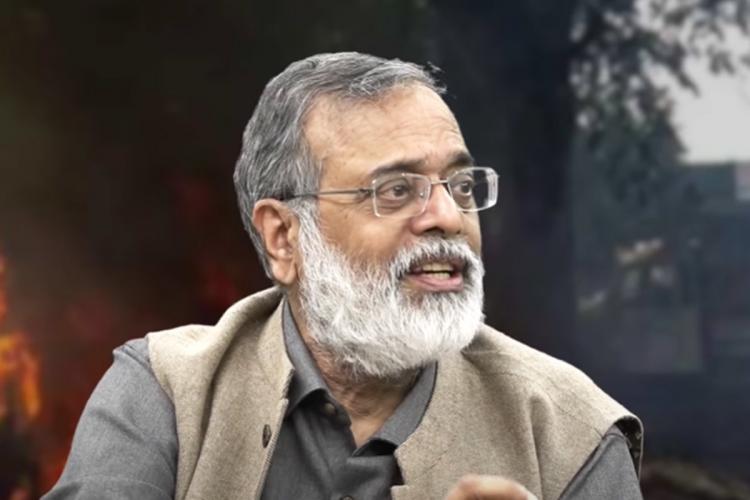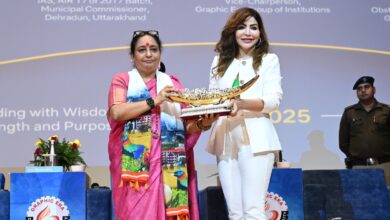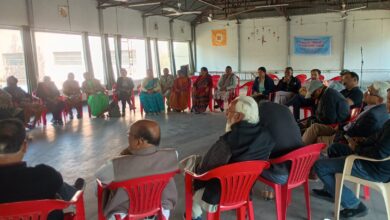Keeping Up The Good Fight

Book Review : Keeping Up The Good Fight – From the Emergency to the Present Day by Prabir Purkayastha Published by Left Word
Rashme Sehgal
Dehradun , Dec 15
The more things change, the more they stay the same.
In India we could well be following this one liner. Or so it would seem going by the nature of governance that is being doled out to its citizens in the last five decades. Prabir Purkayastha, an engineer by profession and a foundational member of the Delhi Science Forum, must have realised this to his dismay when he found himself being arrested by two authoritarian regimes both of whom claimed to be doorkeepers of democracy.
On September 25, 1975, when India was three months into a state of Emergency declared by the then Prime Minister Indira Gandhi, Purkayastha found himself being arrested from the Jawaharlal Nehru University (JNU) by a senior Delhi cop, the burly Deputy Inspector of Police PS Bhinder who was not only a key member of Sanjay Gandhi’s coterie but his pointsman in implementing all his orders.
Bhinder, along with some plain clothes policemen bundled him into a black Ambassador car, all the while asking Purkayastha if he was DP Tripathi, the then president of the students union of JNU. Purkayastha vehemently denied it. Bhinder asked for proof which was not available as few students in the mid-seventies carried ID cards. Those were definitely not the days of the ubiquitous Aadhar card. He was forcibly whisked away to the RK Puram Police Station and detained under the dreaded Maintenance of Internal Security Act which was supposed to continue for a four month period of time with an internal review and further detention if the detainee was seen as a continuing threat.
The reason why this incident is being elaborated upon is because it illustrates just how governments work. Since the police had no evidence of any kind against Purkayastha, the additional district magistrate of South Delhi, P Ghosh refused to sign the MISA warrant. The JNU authorities were contacted and the Dean of Students KP Mishra and the Registrar of the University arrived at the RK Puram thana and made it clear that this was a case of mistaken identity.

With P. Ghosh digging in his heels, his boss the district magistrate Delhi, Sushil Kumar rang him up and warned him that he had to sign the order to arrest Purkayastha as it had emanated directly from the PM’s House, the reference here being clearly made to Sanjay Gandhi. The evidence against Purkayastha was to be produced subsequently by the CID, who a couple of days later came up with this howler to warrant the MISA order.
`He is a staunch SFI worker, who has got good influence on SFI Unit of JNU. Though he took admission only in the year 1975, yet had attracted Miss Ashok Lata Jain due to his political image.’ This then was the evidence that the CID mustered up against Purkayastha which kept him in jail for the next one year. The provocation for Bhinder to enter the JNU campus is equally interesting. The JNU was in a state of ferment ever since Indira Gandhi had declared the Emergency on June 25 1975
and the students’ union had organised a three-day boycott of classes from Sept 24-26. So when Maneka Gandhi arrived at the JNU to attend some classes, she was informed by DP Tripathi and other students that since there was a strike, she should return home. Maneka obviously went back home and informed Sanjay who in turn wanted to know from Bhinder why his wife had been stopped at the JNU.
Cut to February 9 2021 when a posse of men from the Enforcement Directorate conducted a raid on Purkayastha’s house in New Delhi which continued for almost five days, 113 hours to be precise. A warning was being issued against him to rein in the content being published in the digital web platform Newsclick which Purkayastha had started in 2009 much before Modi became Prime Minister. The fact that this young website did not hesitate to expose the wrong doings of both corrupt politicians and their henchmen was something the powers that be were unwilling to accept.
When this warning went unheeded, Officers of the Special Cell of the Delhi Police remanded him and a colleague of his to custody under the dreaded Unlawful Activities ( Prevention) Act . The arrest took place on October 3 2023 and they both remain behind bars to this day.
But before his incarceration, he put together this wonderful book called `Keeping Up The Good Fight’ where he shares his apprehensions about the `undeclared Emergency’ under which we are presently living. His book traces how during the last ten years, ` an atmosphere of hatred and fear has gradually been built up in the country. In the initial years of Modi’s tenure, perhaps this did not seem qualitatively `new’. But it would intensify with two sets of actions that ran on parallel tracks; one, the increasing use of the state’s machinery against activists, newspersons and minorities ; and second, the increasing aggression of the Hindutva forces towards inter-faith marriages ( or relationships) and vigilantism in the name of cow protection. The violence on both counts has become normalised.’
There were several forebodings about what was in store for us citizens. The book traces how the killing of rationalist Narendra Dabholkar in Pune on August 20,2013 who had been fighting against superstition and fraud by `self proclaimed babas’ was the first visible attack against secular intellectuals. This was followed by the killings of the trade unionist Govind Pansare and Prof M.M Kalburgi, an intellectual who had highlighted the anti- caste core of the twelfth century reformer Basavanna. But most shocking was the killing of journalist Gauri Lankesh on September 5 2017, a high profile and highly respected journalist of Bengaluru.
These were all warnings of an undeclared Emergency whose noose is only tightening. If Indira Gandhi’s Emergency had MISA, this present undeclared Emergency has the UAPA, an amended form of the bill being introduced and passed in the Lok Sabha in 2019. This amended act was armed with `special measures’ to deal with terrorism by shifting the burden of proof onto the accused and making bail the exception. This was amply proved in the case of several activists, teachers and writers who were arrested in the Bhima Koregaon case, with many of them continuing to languish in jail even today.
Providing greater teeth to this undeclared Emergency are the different investigative agencies such as the ED, The Economic Offences Wing or the National Investigative Agency who are used to intimidate and arrest all those who dare raise their voice against the government. Of course both
these Emergencies have been backed by their storm troopers. Sanjay Gandhi had his goon brigade while the present regime has their senas and gua rakshaks to intimidate and to lynch.
But the difference between the two is that the Congress did not follow the exclusionary politics that is the key to the RSS mindset which regard the Muslims as being second class citizens . The BJP- RSS want to establish a Hindi-Hindu- Hindu Rashtra and they are working to achieve this goal by taking control of both the media and social media and by eliminating all dissent.
But whereas the coterie surrounding Sanjay Gandhi was well known, little is known about the coterie surrounding Narendra Modi who are focused on building his image as a vishwaguru and a demigod solely focused on uplifting the masses. Sanjay Gandhi’s led no organised movement and the 1977 elections showed his strongarm tactics did not meet with the approval of the public. But the situation today is very different. The carefully crafted image of Modi is the nucleus around which the nation revolves, a myth created by a low key coterie who does his bidding without getting into the public domain.
The book traces Purkayastha’s childhood, his formative years which were spent devouring book after book, his decision to do engineering as also the different ideological influences that shaped his life and led him to become a Marxist. He speaks about his engagement with all manner of Left leaders, Marxists, Naxalites and Trotskyites and the reasons why he finally became a member of the CPI(M). He writes about JNU with a sense of nostalgia and how he got his first taste of a free thinking discussions amongst both the student and teachers in the non hierarchic atmosphere of the university. He writes nostalgically about how he wooed the firebrand student leader Ashoka Lata Jain who he subsequently married following his release from jail. Their marriage was dogged by a tragic turn of events when shortly after the birth of their son, Ashok Lata Jain died very suddenly of a cerebral haemorrhage.
What is fascinating to learn is that following his engineering degree, Purkayastha went on to specialise in computer science having specialised in studying the digital control of power plants. This helped him gain an entry into getting a job with NTPC apart from becoming a member of several government appointed expert groups in the Ministry of Electronics and Information Technology on Industrial Application for almost three decades apart from being a regular attendee on conferences on the subject of Distributed Computer Control Systems.
Alongside, he has worked with several scientists to popularise science and scientific thought with the masses having played an active role in helping found the All India Peoples Science Network and also in starting the Bharat Gyan Vigyan Samiti which organised several Bharat Gyan Vigyan Jathas around the country.
Purkayastha left NTPC and began working as a consultant with different companies. It was while working as a consultant with Steag that he set up the news portal Newsclick. He subsequently joined Thoughtworks a company owned by the American businessman Neville Roy Singham in 2013 and worked there as a consultant in 2017.
It seems ironical that a person of his eminence should he arrested under UAPA. Obviously his ideological commitment and his opposition to the steady take over of the national assets by a handful of capitalists has much to do with his present incarceration.
The book juxtaposes his life story against the major events that impacted the nation makes for compelling reading. In his own words: “ I am as old as the Indian republic. In my life of more than 75 years, I have learnt a thing or two, maybe even three. To put it simply, I have learnt how I can be part of my rich, diverse country, and, equally, part of the fascinating, complex larger world. All I need to do is fight for a better world for all.” May the worthy fight go on.
(Rashme Sehgal is an independent senior journalist.)





